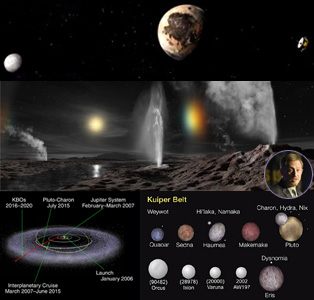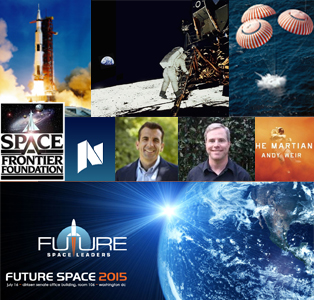New Horizons Encountering New Worlds
|
MONDAY
|

![]() = All times
= All times
for terrestrial events in local time unless noted.
![]() = All times for international terrestrial events in local time unless noted.
= All times for international terrestrial events in local time unless noted.
![]() = All times for space events, and…
= All times for space events, and…
![]() = All times for international space / astro events in Hawaii Standard Time unless noted. Add 10 hours to obtain UT (‘Universal Time;’ Greenwich, England).
= All times for international space / astro events in Hawaii Standard Time unless noted. Add 10 hours to obtain UT (‘Universal Time;’ Greenwich, England).
Weekly Planet Watch – Evening Planets: Venus (W), Jupiter (W), Saturn (S); Morning Planets: Mercury (ENE), Uranus (SE), Neptune (S).
SpaceWeek 2015 Begins Apollo@50 Considerations, Preparations
The week of July 16-24 marks the 20th Century’s signature event, Apollo 11 launch on Saturn 5 rocket from Kennedy Space Center July 16, Neil Armstrong / Buzz Aldrin landing on the Moon July 20 and with Michael Collins the return to Earth via Pacific Ocean splash down on July 24 in 1969. As the Apollo 50th anniversary in 2019 approaches efforts are rising to regain the ultimate “high ground” that can open the rest of the Solar System to Human exploration — the Moon. Space Frontier Foundation presents NewSpace 2015 in Silicon Valley CA July 16-18. A very diverse program includes “The Martian” author Andy Weir (CR), San Jose Mayor Sam Liccardo (CL), speakers from larger firms like Airbus, XCOR, Masten, ULA and Thales Alenia as well as smaller companies and startups such as Firefly, Made In Space, UrtheCast, NanoRacks, Astrobotic, PoliSpace, Deep Space Industries and Vulcan Aerospace. Academics, journalists and NASA / FAA / DARPA government representatives will also participate. Future Space Leaders conference takes place on July 16 at the Dirksen Senate Office Building in Washington DC with the goal of advancing education and professional enrichment of young space professionals and future leaders pursuing careers in the fields of space and satellites. The program includes US Congress representatives Mo Brooks (AL), Donna Edwards (MD), Steve Knight (CA) as well as Senator Cory Gardner (CO). In addition to the many other events during this special 8 day period, on July 18 there will be a launch gala for Buzz Aldrin’s ShareSpace Foundation hosted by John Travolta at Kennedy Space Center FL and Moon Day 2015 events at the Frontiers of Flight Museum in Dallas TX. (Image Credit: SFF, FSLF, NASA) |
Continued from…
TUESDAY
|
![]() Jul 14-16 — National Astronomical Observatories of China, Peking University, Changchun, Jilin, China: East-Asia Active Galactic Nuclei Workshop 2015; at Sheraton Changchun Jingyuetan Hotel.
Jul 14-16 — National Astronomical Observatories of China, Peking University, Changchun, Jilin, China: East-Asia Active Galactic Nuclei Workshop 2015; at Sheraton Changchun Jingyuetan Hotel.
![]() Jul 14 — Moon: 5.9° S of M35, 00:00; 5.5° S of Mercury, 19:00; 5.8° S of Mars, 22:00.
Jul 14 — Moon: 5.9° S of M35, 00:00; 5.5° S of Mercury, 19:00; 5.8° S of Mars, 22:00.
WEDNESDAY
![]() Jul 15 — ULA, Launch Atlas 5 / GPS 2F-10, Cape Canaveral AFS FL: United Launch Alliance Atlas 5 rocket to launch U.S. Air Force 10th Block 2F navigation satellite for Global Positioning System.
Jul 15 — ULA, Launch Atlas 5 / GPS 2F-10, Cape Canaveral AFS FL: United Launch Alliance Atlas 5 rocket to launch U.S. Air Force 10th Block 2F navigation satellite for Global Positioning System.
![]() Jul 15 — Arianespace, Launch Ariane 5 ECA / Star One C4 & MSG 4, Kourou, French Guiana: Arianespace Ariane 5 ECA rocket, designated VA224, to launch Star One C4 and MSG 4 satellites.
Jul 15 — Arianespace, Launch Ariane 5 ECA / Star One C4 & MSG 4, Kourou, French Guiana: Arianespace Ariane 5 ECA rocket, designated VA224, to launch Star One C4 and MSG 4 satellites.
![]() Jul 15 — NASA Space Technology Mission Directorate, Online / Washington DC: Applications Due: NASA Flight Opportunities (FO): Technology Advancement Utilizing Suborbital Flight Opportunities.
Jul 15 — NASA Space Technology Mission Directorate, Online / Washington DC: Applications Due: NASA Flight Opportunities (FO): Technology Advancement Utilizing Suborbital Flight Opportunities.
![]() Jul 15-25 — Jagiellonian University, Jan Kochanowski University, Kielce, Poland: Cosmology School: Introduction to Cosmology.
Jul 15-25 — Jagiellonian University, Jan Kochanowski University, Kielce, Poland: Cosmology School: Introduction to Cosmology.
![]() Jul 15 — Moon: 14.9° S of Castor, 11:00; New Moon, 15:24.
Jul 15 — Moon: 14.9° S of Castor, 11:00; New Moon, 15:24.
![]() Jul 15 — Mercury: 0.17° SW of Mars, 17:00.
Jul 15 — Mercury: 0.17° SW of Mars, 17:00.
![]() Jul 15 — Asteroid 2011 YC29: Near-Earth flyby (0.063 AU).
Jul 15 — Asteroid 2011 YC29: Near-Earth flyby (0.063 AU).
![]() Jul 15 — Asteroid 385186 (1994 AW1): Near-Earth flyby (0.065 AU).
Jul 15 — Asteroid 385186 (1994 AW1): Near-Earth flyby (0.065 AU).
THURSDAY
![]() Jul 16 — Future Space Leaders Foundation, ULA, Arianespace, Lockheed Martin, The Tauri Group, Washington DC: Future Space Leaders 2015; at Dirksen State Senate Office.
Jul 16 — Future Space Leaders Foundation, ULA, Arianespace, Lockheed Martin, The Tauri Group, Washington DC: Future Space Leaders 2015; at Dirksen State Senate Office.
![]() Jul 16 — Canadian Space Commerce Association, Toronto, Ontario, Canada: CSCA membership meeting; featuring Eva Martinez, Vice-President of Women in Aerospace Canada.
Jul 16 — Canadian Space Commerce Association, Toronto, Ontario, Canada: CSCA membership meeting; featuring Eva Martinez, Vice-President of Women in Aerospace Canada.
![]() Jul 16, 17 — Jet Propulsion Laboratory, Caltech/NASA, Pasadena CA: von Kármán Lecture Series: Discovery at Mars; presented by Blaine Baggett.
Jul 16, 17 — Jet Propulsion Laboratory, Caltech/NASA, Pasadena CA: von Kármán Lecture Series: Discovery at Mars; presented by Blaine Baggett.
![]() Jul 16-18 — Space Frontier Foundation, San Jose CA: NewSpace 2015; bringing space startups, established companies, government agencies together with Silicon Valley investors & tech innovators; at Double Tree San Jose.
Jul 16-18 — Space Frontier Foundation, San Jose CA: NewSpace 2015; bringing space startups, established companies, government agencies together with Silicon Valley investors & tech innovators; at Double Tree San Jose.
![]() Jul 16 — Moon: 5.5° SSW of Beehive Cluster, 19:00.
Jul 16 — Moon: 5.5° SSW of Beehive Cluster, 19:00.
![]() Jul 16 — Mercury: At perihelion (0.3075 AU from Sun), 09:00.
Jul 16 — Mercury: At perihelion (0.3075 AU from Sun), 09:00.
![]() Jul 16 — Asteroid 2015 JJ2: Near-Earth flyby (0.090 AU).
Jul 16 — Asteroid 2015 JJ2: Near-Earth flyby (0.090 AU).
FRIDAY
![]() Jul 17-19 — SpaceX, Space Frontier Foundation, Google, et al, San Jose CA: Space Startup Weekend; at DoubleTree Hotel.
Jul 17-19 — SpaceX, Space Frontier Foundation, Google, et al, San Jose CA: Space Startup Weekend; at DoubleTree Hotel.
![]() Jul 17-19 — Calgary Centre of the Royal Astronomical Society of Canada, Eccles Ranch Observatory, Caroline, Alberta, Canada: 2015 Alberta Star-B-Q.
Jul 17-19 — Calgary Centre of the Royal Astronomical Society of Canada, Eccles Ranch Observatory, Caroline, Alberta, Canada: 2015 Alberta Star-B-Q.
SATURDAY
![]() Jul 18 — Frontiers of Flight Museum, The Moon Society, National Space Society of North Texas, Dallas TX: Moon Day 2015; featuring private space traveler Anousheh Ansari, 3 dozen exhibitors, inflatable planetariums, model rocket builds, Solar telescopes, robots, Moon Academy classes, adult-oriented Lunar University lectures, teacher workshops.
Jul 18 — Frontiers of Flight Museum, The Moon Society, National Space Society of North Texas, Dallas TX: Moon Day 2015; featuring private space traveler Anousheh Ansari, 3 dozen exhibitors, inflatable planetariums, model rocket builds, Solar telescopes, robots, Moon Academy classes, adult-oriented Lunar University lectures, teacher workshops.
![]() Jul 18 — ShareSpace Foundation, Kennedy Space Center, NASA, KSC FL: Launch gala for Buzz Aldrin’s ShareSpace Foundation; hosted by John Travolta.
Jul 18 — ShareSpace Foundation, Kennedy Space Center, NASA, KSC FL: Launch gala for Buzz Aldrin’s ShareSpace Foundation; hosted by John Travolta.
![]() Jul 18 — National Museum of the U.S. Air Force, Dayton OH: Family Day; to commemorate 1st humans landing on Moon with Apollo 11 on July 20, 1969, and Apollo 15 – all Air Force crew landing on Moon on July 30, 1971.
Jul 18 — National Museum of the U.S. Air Force, Dayton OH: Family Day; to commemorate 1st humans landing on Moon with Apollo 11 on July 20, 1969, and Apollo 15 – all Air Force crew landing on Moon on July 30, 1971.
![]() Jul 18 — USS Hornet Museum, Alameda CA: Apollo Splashdown Anniversary Celebration; Joe Holt gives a firsthand account of recovering the Apollo 11 lunar landing mission on July 24, 1969.
Jul 18 — USS Hornet Museum, Alameda CA: Apollo Splashdown Anniversary Celebration; Joe Holt gives a firsthand account of recovering the Apollo 11 lunar landing mission on July 24, 1969.
![]() Jul 18 — University of Arizona, Lunar and Planetary Laboratory, Tucson AZ: Space Imagery Center at the Lunar and Planetary Laboratory (LPL) Open House: Summer Science Saturday.
Jul 18 — University of Arizona, Lunar and Planetary Laboratory, Tucson AZ: Space Imagery Center at the Lunar and Planetary Laboratory (LPL) Open House: Summer Science Saturday.
![]() Jul 18 — Moon: 4.0° SSW of Jupiter, 05:00; 0.40° SSW of Venus, 15:00; 3.2° SSW of Regulus, 15:00.
Jul 18 — Moon: 4.0° SSW of Jupiter, 05:00; 0.40° SSW of Venus, 15:00; 3.2° SSW of Regulus, 15:00.
![]() Jul 18 — Mercury: 8.9° S of Castor, 21:00.
Jul 18 — Mercury: 8.9° S of Castor, 21:00.
![]() Jul 18 — Asteroid 242191 (2003 NZ6): Near-Earth flyby (0.083 AU).
Jul 18 — Asteroid 242191 (2003 NZ6): Near-Earth flyby (0.083 AU).
SUNDAY
![]() Jul 19-25 — Rencontres du Vietnam, International Centre for Interdisciplinary Science Education, Quy Nhon, Vietnam: Conference: Planetary Systems – A Synergistic View.
Jul 19-25 — Rencontres du Vietnam, International Centre for Interdisciplinary Science Education, Quy Nhon, Vietnam: Conference: Planetary Systems – A Synergistic View.
![]() Jul 19 — Asteroid 436724 (2011 UW158): Near-Earth flyby (0.016 AU).
Jul 19 — Asteroid 436724 (2011 UW158): Near-Earth flyby (0.016 AU).

